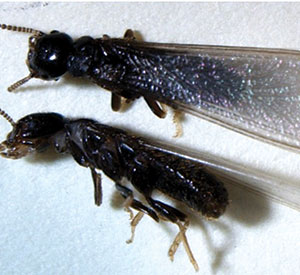June 23, 2020
K-State Guide Helps to Identify Termites, Other Home Pests

Some of them are creepy and crawly. Others can be vicious blood-suckers. Still others slowly whittle away at the wood in your home. But one thing homeowners know about all of the pests they may find is they would rather do without them.
This time of year, that’s nearly impossible, said Kansas State University entomologist Jeff Whitworth, who notes that many of the most common household pests become more active after March each year.
“Arthropods – insects, mites, spiders and others – are our No. 1 competitors for food and fiber, including wooden structures,” Whitworth said. “So, it behooves all of us to know as much as possible about these competitors so that we know which one’s are pests, which one’s are helping us, and the vast majority of which just occupy ecological niches that do not affect us.”
Whitworth is a co-author of the K-State Research and Extension publication, Household Pests of Kansas, a 112-page guide to the most common pests in the Sunflower State.
“This book will help folks identify pests, or identify that the bug they have found is not a pest,” Whitworth said. “If it is a pest to be concerned about, they can read a little about what to expect and how to best get rid of them or keep them out of the house.”
Termites are one of the most worrisome insects for homeowners.
“It’s been said that every wooden structure has had, has, or will have an infestation of these wood-destroying insects,” said Whitworth, noting that termites have “swarmed a little later this year than usual.”
He added that Household Pests in Kansas includes a good description of how to tell the difference between termites and ants, and a recommendation to call a pest control professional as soon as you realize you have termites.
Some of the many pests that Whitworth said homeowners should be aware of include:
* Mosquitos and ticks. Aside from being blood-sucking nuisances, both can vector diseases.
* Spiders. Most are harmless, but often scare homeowners. All spiders are poisonous but only two – the black widow and brown recluse – may require medical attention for both animals and humans.
* Ants. They are mostly just a nuisance, constantly on the search for food scraps. The exception is the carpenter ant, which may start living in soft woods, insulation or other areas.
* Carpenter bees. These are “always” a nuisance in late June to mid-July, Whitworth said. They don’t eat wood, but do tunnel and nest in it. The males have a habit of “dive-bombing” humans who approach their nests before the females have mated.
Most household pests are inactive from October through March, Whitworth said, though a few “pantry pests” stay active during that time because they feed on stored foods that are generally kept at temperatures of 50 degrees Fahrenheit or higher. “Cockroaches and bed bugs can certainly be active year-round, anywhere that temperatures are above 50 F,” he said.
In addition to his publication, Whitworth said two other books – Insects in Kansas and Crop Insects in Kansas – will help homeowners identify pests.
“Your local extension office can also help,” he said. “Take the best, close-up photos you can, from several angles, and place something beside the specimen so the person making the identification can get an idea of size. You can also take the actual specimen in as good of condition as possible to the local Extension office.”
When pest control measures are warranted, Whitworth recommended contacting an established company. “Get several estimates and each company’s tactic to manage your problem,” he said. “They will be different, but they will probably be happy to provide a free estimate. Don’t forget to get a warranty or guarantee, because they should provide these.”